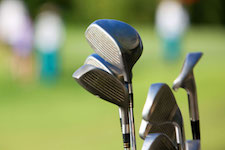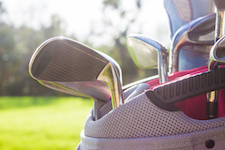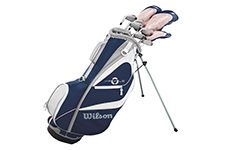HOLE 2:
GOLF EQUIPMENT
As a new golfer, it’s not necessary run out and buy a set of clubs the night before your first lesson nor is it wise to practice with your husband's hand-me-downs. Golf equipment is designed with skill and body size in mind, so it’s important to match clubs to your ability. And while golf requires a short list of necessary equipment, tempting extras, advances in technology and a wide range of price points can quickly make things confusing. In this section, you’ll learn which clubs you need, whether to rent or buy, what you’ll need for lessons and what to pack in your golf bag so you're prepared for the golf course.
RENT UNTIL READY
Rent or Buy
Golf equipment can be an expensive purchase, so most beginners start out renting or using loaner clubs until they develop a golf swing. Golf instructors will typically provide clubs during lessons and clinics, and golf courses keep a number of sets on hand. However, equipment for women may be in short supply, so it's best to call ahead and make sure a set is available - especially if you are left-handed.
Once you’ve committed to the game, a basic set of golf clubs is all you need to be ready for tee time! It’s perfectly acceptable to start with just a few favorites, but as you gain skills, you’ll want a variety of clubs for different situations.
A complete set of women’s golf clubs might include three woods (driver, 3-wood and 5-wood), eight irons (4-iron, 5-iron, 6-iron, 7-iron, 8-iron, 9-iron, a pitch wedge and a sand wedge), two hybrids (5 and 7) and a putter. Any combination is acceptable, but according to the rules of golf, you can’t carry more then 14 clubs in your bag at one time.



Where to Buy
Considering the variety of clubs on the market, different technology features, and wide-ranging price tags, the process of buying a golf set can be overwhelming. As a beginner, you are looking for equipment that will make it easier to hit the ball. The latest technology and most expensive set may not be for you. Shopping for equipment should be one of the fun things about golf, so grab a trusted friend and go!
The best way to decide what to buy is at a location where you can hit a variety of clubs and compare your results. Many golf stores have indoor hitting bays were you can try before you buy. You can also look for "demo days" at local golf courses, when several brands will allow you to try their products on the driving range.
Though you can't test out clubs online, you can quickly compare prices and features. Look for sites with customer service support to answer questions.
Starter Set
Starter sets are a great option for new golfers, as they include a full or partial set of clubs that incorporate technology with beginners in mind. These sets generally include a variety of woods, irons, hybrids, wedges, and a putter. You'll find them typically sold in half (9 clubs) or full (14 clubs) sets, and often with a golf bag included!
Look for packages that include a selection of the higher number woods and irons, because the loft of the club will make it easier to get the ball in the air. As you improve, you can move on to the lower number clubs designed for more distance.
Used Clubs
It’s not a good idea to skimp on modern golf technology for the sake of saving a few dollars. While used sets can be less expensive, they are likely years behind the current technology (and the latest technology helps make you more successful on the course).
Look for woods with large club faces, which are generally more forgiving. See if the irons have perimeter weighting, which will offer the most forgiveness on mis-hits and help compensate for less accurate swings. Go for clubs with graphite shafts, which are lighter and easier to manage then heavier steel shaft construction. Consider a set that includes a hybrid, a smaller faced wood that is generally easier to hit than the lower numbered irons.
Ask when the set was originally purchased, and strike a deal if the answer is within three years!
Customize Your Own Set
You may decide to assemble your own set of clubs purchased all at once or over time. If you are testing out the game or don’t want to invest too much up front, consider buying a few clubs that you are able to hit consistently, along with a putter.
A professional CLUB FITTER can help you determine the best brands and clubs that suit your physical attributes and skill level. A club fitting involves hitting a series of different clubs and brands using tools that measure your swing speed, body measurements and other aspects of your golf swing. As a result, you'll get a recommendation on which clubs to buy with notes on the club length, type of grip and flexibility of the shaft. In theory, the better a club "fits" your individual size and swing, the more chance you will have for success.








